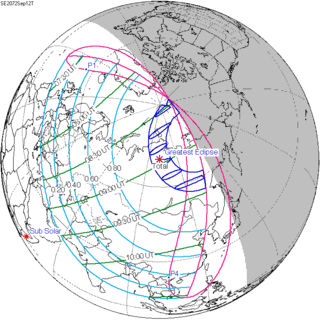Solar eclipse of October 4, 2070
| Solar eclipse of October 4, 2070 | |
|---|---|
 Map | |
| Type of eclipse | |
| Nature | Annular |
| Gamma | -0.495 |
| Magnitude | 0.9731 |
| Maximum eclipse | |
| Duration | 164 sec (2 m 44 s) |
| Coordinates | 32°48′S 60°24′E / 32.8°S 60.4°E |
| Max. width of band | 110 km (68 mi) |
| Times (UTC) | |
| Greatest eclipse | 7:08:57 |
| References | |
| Saros | 135 (42 of 71) |
| Catalog # (SE5000) | 9666 |
An annular solar eclipse will occur on October 4, 2070. A solar eclipse occurs when the Moon passes between Earth and the Sun, thereby totally or partly obscuring the image of the Sun for a viewer on Earth. An annular solar eclipse occurs when the Moon's apparent diameter is smaller than the Sun's, blocking most of the Sun's light and causing the Sun to look like an annulus (ring). An annular eclipse appears as a partial eclipse over a region of the Earth thousands of kilometres wide.
Related eclipses
Solar eclipses 2069-2072
Each member in a semester series of solar eclipses repeats approximately every 177 days and 4 hours (a semester) at alternating nodes of the Moon's orbit.
| 120 | April 21, 2069 Partial |
125 | October 15, 2069 Partial |
| 130 | April 11, 2070 Total |
135 | October 4, 2070 Annular |
| 140 | March 31, 2071 Annular |
145 | September 23, 2071 Total |
| 150 | March 19, 2072 Partial |
155 | September 12, 2072 Total |
Inex series
This eclipse is a part of the long period inex cycle, repeating at alternating nodes, every 358 synodic months (≈ 10,571.95 days, or 29 years minus 20 days). Their appearance and longitude are irregular due to a lack of synchronization with the anomalistic month (period of perigee). However, groupings of 3 inex cycles (≈ 87 years minus 2 months) comes close (≈ 1,151.02 anomalistic months), so eclipses are similar in these groupings.
| Inex series members between 1901 and 2100: | ||
|---|---|---|
 January 14, 1926 (Saros 130) |
 December 25, 1954 (Saros 131) |
 December 4, 1983 (Saros 132) |
 November 13, 2012 (Saros 133) |
 October 25, 2041 (Saros 134) |
 October 4, 2070 (Saros 135) |
 September 14, 2099 (Saros 136) |
||
References
External links
- Earth visibility chart and eclipse statistics Eclipse Predictions by Fred Espenak, NASA/GSFC
